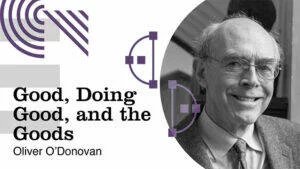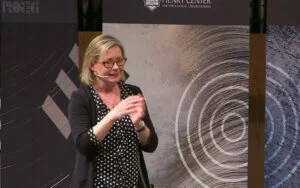“Look at sun that shines upon your brow;
look at the grasses, flowers, and the shrubs
born here, spontaneously, of the earth.
Among them, you can rest or walk until
the coming of the glad and lovely eyes—
those eyes that, weeping, sent me to your side.
Await no further word or sign from me:
your will is free, erect, and whole—to act
against that will would be to err: therefore
I crown and miter you over yourself.”
— Dante, Purgatorio, Canto 27.133-42
Let me begin by registering my appreciation to Dr. Pennington for putting together this very fine text. I’m grateful to be a part of this conversation and for the opportunity to read his excellent book. My task is to examine and evaluate the book from the specific vantage point of theological ethics. I hope to do this in two parts. In part one, I want to think about the overall framework of Pennington’s book and consider flourishing as a primary category for theological ethics. What is gained in this? What might be a lost? And in part two I hope to respond to what I perceive to be a felt need within the text for a more integrated model of discipleship and application of these insights.
To forestall any possible confusion, let me say from the outset that I am on the whole convinced by Pennington’s approach in this book. I would like to see his reading of the Sermon become more influential and provide direction to future scholars, pastors, and the larger church.I would like to see his reading of the Sermon become more influential and provide direction to future scholars, pastors, and the larger church. Regarding what is lost, if we take on Pennington’s approach to the Sermon, we will perhaps lose a naïve confidence that we understand the sermon as a litmus test to be taken simply and evaluated simply. That, I believe, would be a good thing. On the question of what we might gain, I want to begin with his use of the images of a mosaic and a mountain.
Theological ethics can benefit greatly from Pennington’s reading of the Sermon. In particular, we gain a framework for theological ethics based on “a Christo-centric, flourishing-oriented, kingdom-awaiting, eschatological wisdom-exhortation” in the Sermon (xxxv). In short, theological ethics can define the Christian life as “flourishing through wholeness” in Christ. This framework is based on the potential paradigm-shifting observation that, “Jesus’ macarisms are grace-based, wisdom invitations to human flourishing in God’s coming kingdom” (145). To understand the implications of this paradigm shift, however, we must return to the integrative images provided to us by the author: a mosaic and a mountain. These images are, no doubt, carefully selected by Pennington for great effect and in response to what he perceives in the Gospel writer’s own artistry. “He [Matthew] is an artist and a theologian, a theological artist and an artistic theologian” (90). First, let us consider the mosaic.
Flourishing As an Ethical Framework in the Sermon
“A Mosaic”: The mosaic of biblical anthropology that Pennington envisions here provides an encyclopedic approach to cataloging the virtues of Christ-likeness. The image of the mosaic, I believe, is chosen to subtly contrast with any perceived ethical reductionism on the part of less-patient or less-nuanced readings of the Sermon. A mosaic relies on the specificity and particularly of each individual tessera, but no tessera can complete the image on its own. The convergence of many individual aspects creates the overall image of the mosaic. The metaphor of the mosaic, Pennington argues, protects the entire ethical matrix of the Sermon’s expectations:
Views on a wide range of issues are revealed in one’s reaction to the Sermon, including the role of the law in the new covenant, what role virtue plays in one’s ethical system (if any), the importance of acts of piety in the Christian life, the relationship between faith and works, one’s eschatological orientation or lack thereof, the function of suffering in the Christian life, and the idea of God as father, to name a few (xxiii).
The image of a rich and varied mosaic helps keep our horizons open and promote a more holistic interpretation of the sermon, recalibrating our expectations to include a range of options, layers, and new depths for theological ethics. What this means is that the Sermon envisions our transformation into a “new people”—fitted with a renewed “moral imagination” and participating in Christological flourishing (274). Such flourishing is characterized by three things:Pennington’s ultimate aim, however, is that expanding the reader’s “moral imagination” would produce “the highest form of reading, reading for personal transformation. communion with God, consummation in the eschaton, and service that is “missional, priestly, and outward focused” (279). In addition to expanding the range of important categories that feed into “flourishing through wholeness,” he also expands our expectations concerning the scope of change in the Christian life.
“A Mountain”: Pennington’s ultimate aim, however, is that expanding the reader’s “moral imagination” would produce “the highest form of reading, reading for personal transformation” (xxxvi). I am reminded of the sage words of Frederica Mathewes-Green when she said: “Everyone wants to be transformed, but nobody wants to change.” The image of the mountain of righteousness that Pennington offers is a controversial rejoinder to glib hopes for transformation. Rather than allowing readers to persist with a flat or monolithic understanding of the Sermon as taking us to a new plateau or field, he forces us to look up at the awesome and intimidating mountain of righteousness—a fitting image for the ascent all Christians must make for the “greater righteousness” to which Jesus calls us in Matt. 5:17-20 (99). Within this image, Jesus’ fulfillment of the Law and the Prophets retains its place of utmost significance, and as Pennington explains, what we are dealing with here is “the question of the relationship of Jesus’ person and work to the whole covenant God made with Israel through the mediation of Moses. This ups the ante on the discussion and also reorients to a covenantal discussion instead of merely ethical one” (157). We become obedient to Jesus’ command and so participate in his fulfillment when we pursue his righteousness for actual growth. Pennington clarifies: “A virtue ethics rooted in Scripture is superior because it directs our attention to the kind of person that God wants for his creatures and because it directs our attention toward the biblical emphasis on growth and growth through habituation in the Christian life” (285). Growth—not duty, not payment, not recompense, not toil—is the means of flourishing through wholeness and ascending the mountain of righteousness. In the words of the prophet Jeremiah, “But I will give you your life as a prize of war in all places to which you may go” (Jer. 45:5).
An Integrative Model of Discipleship in Dietrich Bonhoeffer
Next, I wish to point out a significant felt need in the text: the need for a more integrative model of discipleship. This need can be illustrated principally by the discussion around thesis four in the concluding chapter of the book, which states: “The sermon teaches that salvation is inextricably entailed with discipleship/virtuous transformation” (285-89). Here, Pennington is atAs the pure expression of Jesus’ demands for his disciples, the Sermon captured Bonhoeffer’s imagination and his life more than any other biblical passage. pains to demonstrate that the virtue formation we are called to in the Sermon is not at odds with the gift of God’s grace. The following is certainly representative of his concern: “In short, I suggest that it is a misunderstanding of Paul if one reads him as being in conflict with Jesus’s emphasis on discipleship and the necessary and effectual work of God’s grace given to believers through the Holy Spirit” (286). This is not a simple dynamic to navigate, but considerable help is available from Dietrich Bonhoeffer. The most widely read and certainly most significant work in English by Bonhoeffer is The Cost of Discipleship, and it is in large part his theological commentary on the Sermon. So, I find it troubling that Bonhoeffer is missing from Pennington’s account and particularly his recap of engagements with the Sermon in modern theology (Cf. xxxii). In the remaining space, I would like to recount briefly Bonhoeffer’s profound encounter with the Sermon and his substantial enactment of its holistic message in his own ministry. I hope to do so through a brief but concentrated review of his theology of discipleship from the Sermon.
Pennington identifies three questions that virtue ethics answers: “Who are we? Who ought we to become? How do we get there?” (16). Bonhoeffer found deep and satisfying answers to each of these in the Sermon on the Mount. As the pure expression of Jesus’ demands for his disciples, the Sermon captured Bonhoeffer’s imagination and his life more than any other biblical passage. Here, Jesus was no longer the refuge of small faith, but rather the Lord who must be pursued with obedient action.Krötke provides this commentary: “Bonhoeffer explained the indissoluble relation between faith and obedience in Discipleship as being based on the present ‘incarnate God’s’ calling people into discipleship by carrying the cross of Christ and the experience of the presence of the ‘exalted Christ’ in word and sacrament. The whole Christ, who brings about faith, is not present for us apart from his call to obedience.” Krötke, “Dietrich Bonhoeffer and Martin Luther,” 73. Pennington expresses similar wonder: “In the Sermon we meet a person who is simultaneously the fulfillment and incarnation of both [virtue leading to human flourishing and the kingdom of God]; he is the complete and virtuous human and the true king” (xxxv). In a particularly candid letter of 1935 to his older brother Karl-Friedrich, Bonhoeffer reflects:
When I first started in theology, my idea was quite different—rather more academic, probably. Now it has turned into something else altogether. But I do believe that at last I am on the right track, for the first time in my life… I think I am right in saying that I would only achieve true inner clarity and honesty by really starting to take the Sermon on the Mount seriously… The restoration of the church must surely depend on a new kind of monasticism which has nothing in common with the old but a life of uncompromising discipleship, following Christ according to the Sermon on the Mount. I believe the time has come to gather people together and do this.“Letter to Karl-Friedrich Bonhoeffer (January 14, 1935),” in Dietrich Bonhoeffer, London: 1933-1935, ‘Dietrich Bonhoeffer Works English’ Vol. 13, [London: 1933-1935] Edited by Keith Clements, Translated by Isabel Best. (Minneapolis: Fortress Press, 2007), 284-85.
Not only a blueprint for his own ministry of leading the Brothers’ Seminary at Finkenwalde and Zingst, the Sermon was most powerfully enacted in Bonhoeffer’s life through his theology of discipleship.
Bonhoeffer’s Enactment of the Sermon
To summarize briefly his theology of discipleship, I will proceed through four important movements in his reading of the Sermon, which roughly correspond to the first four chapters of The Cost of Discipleship. These four convictions form the basis of his theological interpretation of the Sermon and precede his commentary on the text.
- “Costly Grace versus Cheap Grace”: Perhaps the most recognizable claim from Bonhoeffer’s most famous work, this powerful contrast encapsulates so much of what his reading of the Sermon aimed to resist. Namely, he wanted to obliterate the false theology that gave lip service to the demands of the gospel but secretly held that, “Cheap grace means the justification of the sin without the justification of the sinner. Grace alone does everything, they say, and so everything can remain as it was before.”Dietrich Bonhoeffer, Discipleship, ‘Dietrich Bonhoeffer Works English,’ Vol. 4, [Nachfolge] Edited by Geffrey B. Kelly and John D. Godsey, Translated by Barbara Green and Reinhard Krauss, (Minneapolis: Fortress Press, 2001), 43. Here, Bonhoeffer helpfully clarifies that while the gospel’s proclamation must celebrate the grace of God’s free gift of salvation, the life of discipleship will be incomplete without an ethic of obedience to Christ’s actual demands.
- Obedience: Next, Bonhoeffer develops the somewhat paradoxical thesis: “only the believers obey, and only the obedient believe.”DBWE Vol. 4, 63. Hereafter referred to as DBWE, Vol. 4. Krötke asserts: “But one thing is clear: in all the important questions that must be decided in the doctrine of Christology, Bonhoeffer took his bearings from Luther.” And, “For him [Bonhoeffer], Luther’s teaching of Christ’s vicarious representation in his death for us always remained an incontestable and central point of reference for his thinking and faith.” Krötke, “Dietrich Bonhoeffer and Martin Luther,” 60; 63. Obedience is actually necessary. This seems to be the nature of Christ’s command in Matthew 5:17-20 concerning the fulfillment of the Law and the Prophets. Reminiscent of Luther’s paradoxical claim in On Christian Liberty, this dialectical characterization of the relationship between belief and obedience in the disciple’s life seems to helpfully alleviate some of the angst in Pennington’s efforts at balancing grace and virtue. Indeed, obedience, it seems, is what Pennington intimates when he utilizes John Barclay’s phrase: “unconditioned but not unconditional” (288). Obedience, however, is not self-initiated for Bonhoeffer but rather the enablement that comes from the calling of Christ on the individual disciple.
- The Call of Christ: For Bonhoeffer, the call of Christ breathes life into the disciple and animates both belief and obedience. He explains: “So the call to discipleship is a commitment solely to the person of Jesus Christ, a breaking through of all legalisms by the grace of him who calls. It is a gracious call, a gracious commandment. It is beyond enmity between law and gospel. Christ calls; the disciple follows. That is grace and commitment in one.”DBWE Vol. 4, 59. How the Sermon issues to us the call of Christ, Pennington and Bonhoeffer seem to understand something similar about its purpose, for Pennington says that, “These two [righteousness and virtue] come together in the vision of what it means to be a follower/imitator of Jesus, which is the ultimate perlocutionary purpose of the sermon” (292). Because the flourishing through wholeness model of Pennington’s reading sees this new life as a great mountain rather than a mere portal, it is important to go one stage further in Bonhoeffer’s theology of discipleship.
- Suffering and Joy: Bonhoeffer declares that, “Discipleship is joy.” But he elaborates: “Discipleship is being bound to the suffering Christ. That is why Christian suffering is not disconcerting. Instead, it is nothing but grace and joy . . . In the middle of the most terrible torment that the disciples bore for their Lord’s sake, they experienced the greatest joy and blessedness of his community. Bearing the cross proved to be for them the only way to overcome suffering. But this is true for all who follow Christ, because it was true for Christ himself.”Ibid., 89. These words still appear counterintuitive and absurd to all who cannot recognize the paradoxical, eschatological orientation of Christ’s vision of flourishing. Pennington indicates as much in his description of the Beatitudes: “They present true human flourishing as entailing suffering as Jesus’ disciples await God’s coming kingdom that Jesus is inaugurating” (137).
While much more could be said, this all-too-brief sketch of Bonhoeffer’s theology of discipleship hopefully indicates that the reconciliation of grace and virtue that Pennington expects has already been suggested by Bonhoeffer’s poignant text on discipleship (Cf. Pennington 288, 290, 292). Surprisingly, Bonhoeffer rejected a reading of the Sermon based on the Lutheran orthodoxy of the Two Kingdoms in favor of a more faithful reading that elevated both belief and obedience. Unfortunately, it cost him his life. Among his final reflections from a Nazi prison, we find him returning to particular theme of devotedness to Christ (i.e. wholeness despite suffering), what he called “the profound this-worldliness of Christianity”:
Later on I discovered, and am still discovering to this day, that one learns to have faith by living in the full this-worldliness of life. If one has completely renounced making something of oneself—whether it be a saint or a converted sinner or a church leader (a so-called priestly figure!), a just or an unjust person, a sick or healthy person—then one throws oneself completely into the arms of God, and this is what I call this-worldliness: living fully in the midst of life’s tasks, questions, successes and failures, experiences, and perplexities—then one takes seriously no longer one’s own sufferings but rather the suffering of God in the world. Then one stays awake with Christ in Gethsemane.DBWE Vol. 8, 486/







Comments
Be the first one to make a comment!